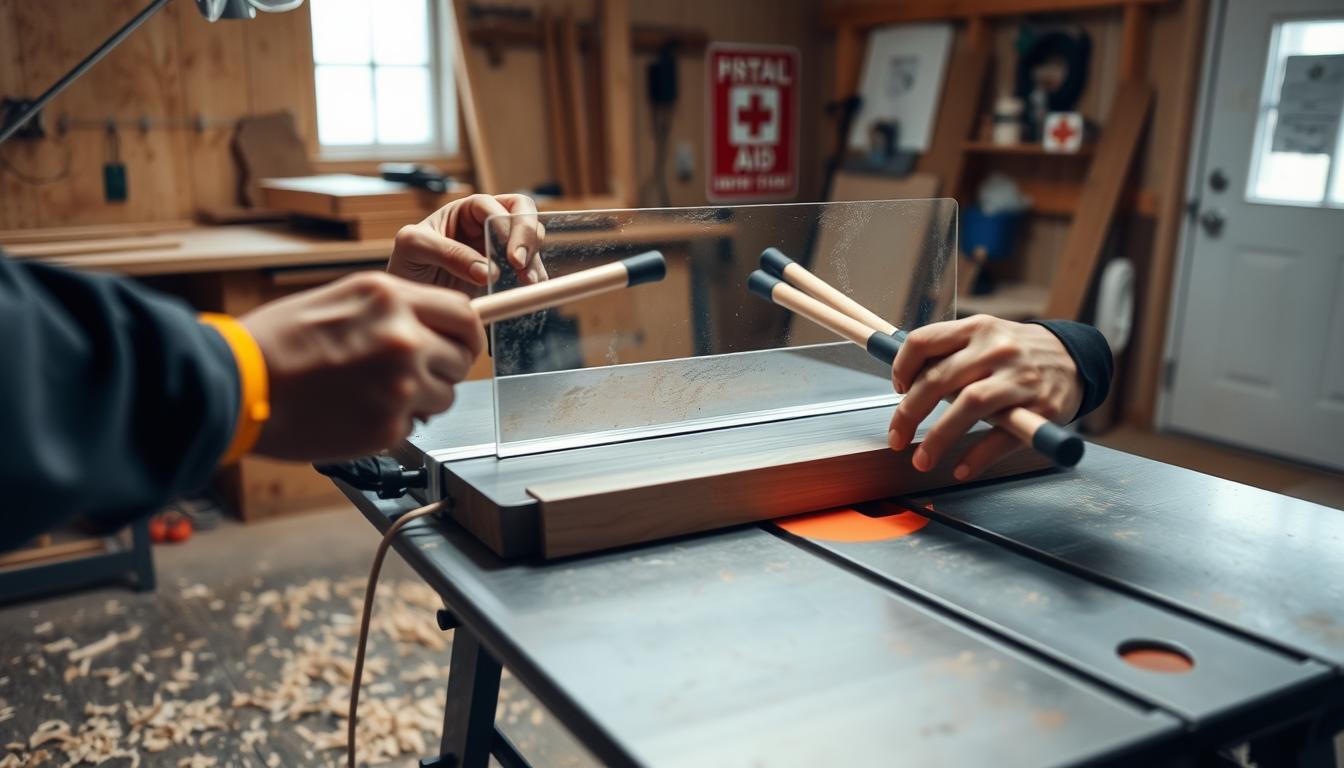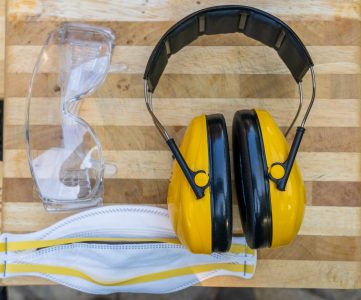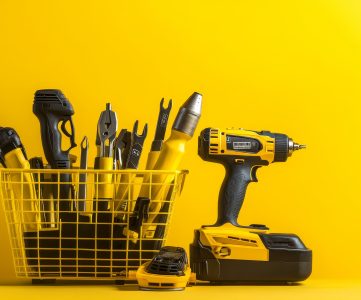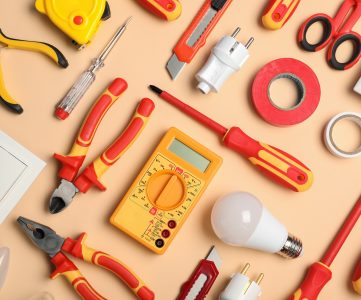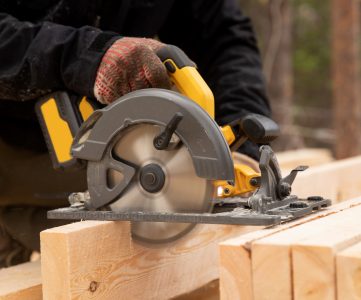Working with power tools like table saws requires a focus on safety. Knowing the basics of woodworking safety is key to avoiding accidents. Table saws are powerful and need respect and caution.
Whether you’re new or experienced, table saw safety is crucial. Following best practices helps you work safely and efficiently. This way, you can protect yourself and achieve professional results.
Introduction to Table Saw Safety
Table saws are essential in woodworking shops, and their safe use is vital. By focusing on table saw safety, you can enjoy woodworking without risks. This guide will share important tips for safe table saw use, helping you work confidently.
Key Takeaways
- Prioritize table saw safety to prevent accidents and injuries
- Understand the basics of woodworking safety for a successful experience
- Follow proper guidelines for table saw operation and maintenance
- Minimize risks by creating a safe workspace and following best practices
- Embracing table saw safety principles will help you work efficiently and effectively
- Focus on woodworking safety to protect yourself from potential hazards
Understanding Your Table Saw: Basic Components and Features
To get the most out of your table saw, knowing its parts and features is key. This knowledge helps with setting up your saw right and mastering different techniques. A standard table saw has main parts like the blade, table, and fence.
There are different types of table saws, like contractor, cabinet, and hybrid saws. Each type has its own power and motor specs. Knowing these differences helps you pick the right saw for your projects and use the right blades and accessories.
- Blade: The cutting tool of the saw
- Table: The flat surface where the material is placed
- Fence: The guide that helps with accurate cuts
By getting to know these components and features, you’ll set up your table saw better. This improves your woodworking skills and makes your work safer.
Critical Safety Measures Before Starting
When using power tools like table saws, workshop safety is key. Always put on safety gear, like safety glasses and ear protection. This helps avoid injuries from flying debris or loud sounds.
A clean and organized workspace is also vital for table saw safety. Make sure your clothes and hair are not loose. Also, keep the area free of clutter. This makes your work safer and smoother. Always read and follow the table saw’s instructions to know its safety rules.
- Wear protective gear, including safety glasses and ear protection
- Keep loose clothing and long hair tied back
- Ensure the work area is clear of debris and obstacles
- Read and follow the manufacturer’s instructions for your table saw model
By following these safety steps, you can lower the risk of accidents. This makes your woodworking project safe and successful. Remember, workshop safety and table saw safety are crucial for a good woodworking experience.
Proper Table Saw Setup and Workspace Organization
Setting up your table saw and workspace is key for safe and efficient work. A tidy workspace prevents accidents and boosts your work quality. When setting up your table saw, aim for the best height and spot. This makes working comfortable and keeps you in control.
Don’t forget about workshop safety. Good lighting is crucial for clear work visibility. Also, a dust collection system keeps your space clean and safe.
Optimal Height and Position
The table saw should be at a height that doesn’t strain your back. It should also be placed for easy access and movement around the area.
Lighting Requirements
Good lighting is essential for safe and precise work. Think about adding extra lights, like overhead or task lights, to brighten up your space.
Dust Collection System Setup
A dust collection system is key for a clean and safe workspace. Install a dust collector or vacuum to cut down on dust and debris.
By following these tips, you can make a safe and efficient workspace. Always put workshop safety first and take steps to prevent accidents.
| Workspace Component | Importance |
|---|---|
| Table Saw Height | High |
| Lighting | High |
| Dust Collection System | High |
Essential Safety Equipment and Gear
When it comes to woodworking safety, having the right equipment is key. This includes push sticks, featherboards, and safety glasses. Knowing how to use these tools is crucial to avoid injuries and keep the workspace safe. Proper saw techniques also help maintain a safe environment.
A well-stocked first aid kit is also essential in case of accidents. Other important safety equipment includes:
- Hearing protection
- Dust masks
- Steel-toed boots
By investing in the right safety equipment, woodworkers can reduce injury risks. This lets them focus on improving their saw techniques and woodworking skills. Always remember, woodworking safety is the top priority in the workshop.
Choosing and Installing the Right Blade
The right blade is key for quality cuts and safety. Different blades are for different tasks. For example, a rip blade is best for straight cuts, while a crosscut blade is better for cutting across the grain.
Proper installation is also vital. This means aligning and tightening the blade correctly. Regular maintenance, like cleaning and sharpening, also helps. By choosing the right blade and following installation techniques, you can get professional results safely.
Blade Types and Their Uses
- Rip blade: for making straight cuts in wood
- Crosscut blade: for cutting across the grain
- Combination blade: for general-purpose cutting
Proper Installation Techniques
Installing the blade correctly is crucial for safety and effectiveness. Align it with the table saw’s arbor and tighten it well. Using the right blade and following these steps ensures accurate cuts and safety.
Blade Maintenance Tips
Regular maintenance extends your blade’s life and improves its performance. Clean it often and sharpen it when needed. These steps help you achieve top results and keep your workspace safe.
Mastering Basic Table Saw Techniques
Learning basic table saw techniques is key for woodworkers. It keeps you safe and helps you get precise results. You’ll need to know how to make straight, bevel, and miter cuts safely and well.
Some important techniques to learn include:
- Using the fence and miter gauge to guide the stock
- Properly feeding stock through the saw to prevent kickback
- Maintaining a safe distance from the blade
By mastering these basics, you’ll stay safe and get professional-looking results. Remember, practice is essential. It might take time to get better, but don’t give up.
With patience and hard work, you’ll become skilled at using a table saw. You’ll be ready to take on many projects with confidence and precision.
Advanced Cutting Methods and Jigs
As you get better with your table saw, you can try new cutting methods and jigs. This will make your workshop safer and your cuts more precise. Creating custom push blocks is a great way to start. They help you make accurate cuts and control your workpieces better.
Some important things to think about for advanced cutting methods include:
- Using a miter saw or a crosscut sled for cross-cutting techniques, which can simplify your workflow and improve accuracy
- Implementing dado and groove cutting techniques, which require specific jigs and saw techniques for accurate results
- Developing a thorough understanding of your table saw’s capabilities and limitations to ensure safe and effective operation
Mastering these advanced cutting methods and jigs will boost your table saw skills. It also makes your workshop safer. Always follow the right saw techniques and safety rules for a safe and successful cut.
Some popular jigs and accessories for advanced cutting methods include:
- Crosscut sleds
- Dado sets
- Push blocks
These tools help you make precise cuts and keep your workshop safe. But, it’s key to use them with the right saw techniques and safety rules.
Maintenance and Troubleshooting Guide
Keeping your table saw in top shape is key for safety and efficiency. Regular upkeep can stop common issues and cut down on troubleshooting. Choosing the right blade is also vital for quality cuts and saw performance.
Make sure to clean your saw, check and swap blades, and oil moving parts regularly. This helps avoid problems like uneven cuts or blade drift. Knowing how to fix common issues quickly gets you back to work fast.
Regular Maintenance Schedule
- Clean the saw often to stop dust and debris buildup
- Check and replace blades as needed for best performance
- Lubricate moving parts to cut down on friction and wear
Common Problems and Solutions
Table saw issues like uneven cuts, blade drift, and motor problems are common. Check your setup and blade to make sure they’re right. If unsure, refer to your manual or seek a pro’s help.
Stick to a regular maintenance plan and know how to fix common problems. This keeps your table saw running well and safely. Always wear safety gear and seek help if unsure about maintenance or troubleshooting.
Conclusion: Embracing Safe and Effective Table Saw Practices
As we wrap up our exploration of table saws, it’s clear that safety and efficiency are key. Understanding your table saw’s parts and following safety rules are crucial. These steps will help you create great projects while keeping you safe.
The table saw is a powerful tool that needs respect and care. Spending time on setup and keeping your equipment in good shape is important. This way, you’ll improve your skills and make the most of your table saw.
Whether you’re experienced or new to woodworking, follow the guide’s advice. This will help you make beautiful pieces and keep you safe. Happy woodworking, and may your projects turn out well!
